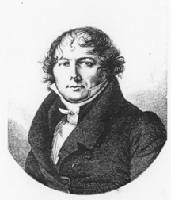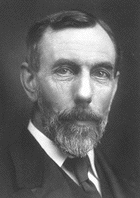
The History of Cosmic Ray Studies
1800 - 1899
- 1803
- Modern atomic theory is put forward by John Dalton
- 1804
 The French Academy of Sciences, questioning the accuracy of previous upper-air data, commissioned physicists Biot and Gay-Lussac to make scientific observations. In flights together on August 24 to 4000 m. and by Gay-Lussac alone on September 15 to 7000 m (hydrogen balloons), they measured, within this atmospheric layer, uniformity of gravitation, terrestrial magnetism, and air composition.
The French Academy of Sciences, questioning the accuracy of previous upper-air data, commissioned physicists Biot and Gay-Lussac to make scientific observations. In flights together on August 24 to 4000 m. and by Gay-Lussac alone on September 15 to 7000 m (hydrogen balloons), they measured, within this atmospheric layer, uniformity of gravitation, terrestrial magnetism, and air composition. - the 1800s
- The science of astrophysics was born with the invention of spectroscopy (spreading light into the colors that make up its spectrum). The spectrum of each celestial body viewed through the spectroscope shows lines characteristic of the elements present, a powerful new tool. The ability to determine the chemical composition of planetary atmospheres and stars now became possible.
- 1814, Joseph von Fraunhofer invented the spectroscope and, in the following years, provided a detailed description of the solar spectrum.
- 1862, Anders Angstrom observed hydrogen in the Sun.
- 1863, William Huggins discovered stellar spectra that indicated that stars are made of same elements as found on Earth.
- 1819
- Hans Orsted discovered electromagnetism
- 1837
- Dr. John Rae, a trader and surgeon for the Hudson Bay Company, tried unsuccessfully to raise a balloon by the Sun's heat alone.
- 1843
- Sunspot cycle is identified by Samuel Schwabe
- 1848
- Beginning of the American Association for the Advancement of Science
(AAAS)
- 1852
- Astronomers link sunspot cycle to geomagnetic activity
- 1858
- Richard Carrington and R. Hodgson discovered that the Sun rotates
at different speeds at different latitudes
- 1859
- First observation of a solar flare, by Richard Carrington
- 1860
- First observation of a coronal mass ejection (CME)
- 1863
- Establishment of the U.S. National Academy of Sciences
- 1865
- James Clerk Maxwell predicted that electromagnetic waves travel at
the speed of light
- 1869
- Dmitri Mendeleyev published the periodic table of the elements.
- 1869
- Journal of Nature first published
- 1873
- James Clerk Maxwell described light as electromagnetic radiation
- 1879
- Speed of light was calculated by Albert Michelson to be 186,350
miles per second
- 1881
- First issue of Science magazine published
- 1887
- Albert Michelson and Edward Morley run experiments that show that the
speed of light remains constant
- 1887
- Heinrich Hertz predicted the existence of radio waves and
successfully detected them in 1888
- 1892
- Hermite and Besancon developed instruments for unmanned high-altitude flight.
- 1895

William Ramsay discovered helium in the atmosphere (previously observed by Jenssen and Lockyer in 1868).- 1895
- William Roentgen discovers X-rays
- 1896
- Henri Becquerel discovers natural radioactivity
- 1896
- Kristian Berkeland proposed that electrical rays from the Sun cause
aurorae
- 1897
- J.J. Thomson discovers electrons, the first sub-atomic particles
- 1898
- Wilhelm Wien discovers a positive particle, later known as the
proton
- 1898
- Ernest Rutherford discovered alpha and beta rays
- 1899
- Founding of the American Physical Society
Back to main history page






Click on images above to
learn more about them
A service of the Heliophysics
Science Division at NASA's GSFC
Questions and comments to: cosmicopia@cosmicra.gsfc.nasa.gov
Curator: Dr Eric R. Christian, NASA
Responsible NASA Official: Dr Eric R. Christian
Privacy Policy and Important Notices
Questions and comments to: cosmicopia@cosmicra.gsfc.nasa.gov
Curator: Dr Eric R. Christian, NASA
Responsible NASA Official: Dr Eric R. Christian
Privacy Policy and Important Notices

HOME
In the News
History
Ask Us
Great Links
Glossary
Site Map
Search NASA